Holly Thompson's Blog, page 24
March 21, 2014
COETAIL: Author Skype Visit
Another post toward my Certificate in Educational Technology and Information Literacy (COETAIL)
Today I started the day with students many miles away: I made an author Skype visit with grade seven students at Hammond Academy of Science and Technology in Indiana, a school that I have virtually visited previously.
These grade seven students had already each written a novel this year with NaNoWriMo--it is always a special pleasure to speak with young writers who have drafted an entire novel since they have a keen awareness of the challenge of creating plot, suspense, and emotional power in a novel.
This year the teachers at Hammond Academy had combined the study of my novel Orchards with global studies and even created their own Obon celebration. Though it may seem oddly timed to hold a summer Obon Festival in March, the Vernal Equinox or shunbun no hi is also a time in Japan for honoring ancestors and visiting the family graves to wash the tombstones, make offerings of food and flowers, and pay respects. The students' celebration was thus beautifully timed.
At the Hammond Academy Obon Festival, students learned the tanko-bushi coal miner's dance--my personal favorite at Obon celebrations--and they made beautiful lanterns . . .
 Student created lanternsand carried them around the school in a procession to honor family and loved ones both living and dead. You can read more about the Hammond Academy Obon Festival here.
Student created lanternsand carried them around the school in a procession to honor family and loved ones both living and dead. You can read more about the Hammond Academy Obon Festival here.
During our morning Skype visit, I talked about the inspiration for Kana's story in Orchards and showed images (via a PowerPoint presentation sent to the teacher in advance) of the Shizuoka agricultural village setting for Orchards, as well as photos from my mikan orange farm work that enabled me to write the story. I also shared images of the Obon rituals particular to that coastal area of the Izu Peninsula of Japan. Via collaboration across many miles, and through a book, technology and a class project these students have gained a global experience. I look forward to receiving the students' Obon reflections--coming my way soon, I'm told!

After my PowerPoint presentation to the students, the teacher invited selected "chosen ones" to come forward to the computer and read prepared questions to me. The Q&A covered plotting points, bullying and depression issues in Orchards, reasons for writing in verse, why and when I decided to become a writer, the publication journey, ways for authors to brainstorm and draft, and more. Students also shared some great ideas about prequels and sequels for Orchards. Maybe I should collaborate with the amazing grade 7 students of Hammond Academy of Science and Technology and give a sequel a go! Thank you, HAST, for a great Skype visit.
Today I started the day with students many miles away: I made an author Skype visit with grade seven students at Hammond Academy of Science and Technology in Indiana, a school that I have virtually visited previously.
These grade seven students had already each written a novel this year with NaNoWriMo--it is always a special pleasure to speak with young writers who have drafted an entire novel since they have a keen awareness of the challenge of creating plot, suspense, and emotional power in a novel.
This year the teachers at Hammond Academy had combined the study of my novel Orchards with global studies and even created their own Obon celebration. Though it may seem oddly timed to hold a summer Obon Festival in March, the Vernal Equinox or shunbun no hi is also a time in Japan for honoring ancestors and visiting the family graves to wash the tombstones, make offerings of food and flowers, and pay respects. The students' celebration was thus beautifully timed.
At the Hammond Academy Obon Festival, students learned the tanko-bushi coal miner's dance--my personal favorite at Obon celebrations--and they made beautiful lanterns . . .
 Student created lanternsand carried them around the school in a procession to honor family and loved ones both living and dead. You can read more about the Hammond Academy Obon Festival here.
Student created lanternsand carried them around the school in a procession to honor family and loved ones both living and dead. You can read more about the Hammond Academy Obon Festival here.During our morning Skype visit, I talked about the inspiration for Kana's story in Orchards and showed images (via a PowerPoint presentation sent to the teacher in advance) of the Shizuoka agricultural village setting for Orchards, as well as photos from my mikan orange farm work that enabled me to write the story. I also shared images of the Obon rituals particular to that coastal area of the Izu Peninsula of Japan. Via collaboration across many miles, and through a book, technology and a class project these students have gained a global experience. I look forward to receiving the students' Obon reflections--coming my way soon, I'm told!

After my PowerPoint presentation to the students, the teacher invited selected "chosen ones" to come forward to the computer and read prepared questions to me. The Q&A covered plotting points, bullying and depression issues in Orchards, reasons for writing in verse, why and when I decided to become a writer, the publication journey, ways for authors to brainstorm and draft, and more. Students also shared some great ideas about prequels and sequels for Orchards. Maybe I should collaborate with the amazing grade 7 students of Hammond Academy of Science and Technology and give a sequel a go! Thank you, HAST, for a great Skype visit.
Published on March 21, 2014 13:26
March 19, 2014
COETAIL: Teaching with Poetry Pairings
Did you know that the New York Times Learning Network features weekly Poetry Pairings?
In these New York Times pairings, in addition to providing two very different approaches to a topic--poetry opposite a NewYork Times article--that can stimulate discussions and offer opportunities for explorations of comparison and analysis, these cross-discipline pairings can also be used to provide inspiration for students to create their own pairings of a text with an original poem (or other art forms, such as dance, drama, musical composition, visual art, film, etc.).
In my university poetry classes, each year we have done a version of creative poetry pairing: I ask students to select a newspaper article about a news event, then create a poem inspired by that article. They include both the original poem and the news article in their final poetry portfolio.
Writers often find inspiration from news events; we mull and compost ideas and remold the news into poems or stories. Last year, research in news archives for a short story I was writing led also to this poem "Comet Hunter."
With the aim of working toward creating more poetry pairings in the classroom, I searched for companion pieces to pair with "Comet Hunter," just published in The Poetry Friday Anthology for Science. The poem is included in the section Poems for Fifth Grade. It's a brief narrative poem about amateur astronomer Yuji Hyakutake who discovered Comet Hyakutake in 1996. The comet was considered the Great Comet of the Century . . . until Hale-Bopp upstaged it in 1997.
"Comet Hunter" was written for an elementary school audience. In the K-5 Teacher Edition of The Poetry Friday Anthology for Science, editors Sylvia Vardell and Janet Wong suggest pairing "Comet Hunter" with another poem in the collection. They also suggest using a comet video without sound as an effective backdrop during reading and recommend picture books relating to comets and space for additional pairings.
 Following are some additional options that I recommend for poetry pairings with "Comet Hunter."
Following are some additional options that I recommend for poetry pairings with "Comet Hunter."
On the topic of Yuji Hyakutake:
Simple nonfiction from Sky and Telescope
How Yuji Hyakutake Found His Comet.
Yuji Hyakutake's Press Statement: How Comet Hyakutake B2 Was Discovered .
On the topic of comets:
Euronews video about the comet-hunting spacecraft Rosetta: Rosetta: The Comet Hunter Awakes
NY Times article Comet, Thought Dead But Found Alive, Is Now Fading Away, Astronomers Say
Other poems to pair with "Comet Hunter":
Walt Whitman's When I Heard the Learn'd Astronomer
Stanley Kunitz's Halley's Comet
I hope that teachers of all subject areas and all age groups will be inspired to try creating poetry pairings. Poetry offers us fresh ways to consider any topic.
In these New York Times pairings, in addition to providing two very different approaches to a topic--poetry opposite a NewYork Times article--that can stimulate discussions and offer opportunities for explorations of comparison and analysis, these cross-discipline pairings can also be used to provide inspiration for students to create their own pairings of a text with an original poem (or other art forms, such as dance, drama, musical composition, visual art, film, etc.).
In my university poetry classes, each year we have done a version of creative poetry pairing: I ask students to select a newspaper article about a news event, then create a poem inspired by that article. They include both the original poem and the news article in their final poetry portfolio.
Writers often find inspiration from news events; we mull and compost ideas and remold the news into poems or stories. Last year, research in news archives for a short story I was writing led also to this poem "Comet Hunter."
With the aim of working toward creating more poetry pairings in the classroom, I searched for companion pieces to pair with "Comet Hunter," just published in The Poetry Friday Anthology for Science. The poem is included in the section Poems for Fifth Grade. It's a brief narrative poem about amateur astronomer Yuji Hyakutake who discovered Comet Hyakutake in 1996. The comet was considered the Great Comet of the Century . . . until Hale-Bopp upstaged it in 1997.
"Comet Hunter" was written for an elementary school audience. In the K-5 Teacher Edition of The Poetry Friday Anthology for Science, editors Sylvia Vardell and Janet Wong suggest pairing "Comet Hunter" with another poem in the collection. They also suggest using a comet video without sound as an effective backdrop during reading and recommend picture books relating to comets and space for additional pairings.
 Following are some additional options that I recommend for poetry pairings with "Comet Hunter."
Following are some additional options that I recommend for poetry pairings with "Comet Hunter."On the topic of Yuji Hyakutake:
Simple nonfiction from Sky and Telescope
How Yuji Hyakutake Found His Comet.
Yuji Hyakutake's Press Statement: How Comet Hyakutake B2 Was Discovered .
On the topic of comets:
Euronews video about the comet-hunting spacecraft Rosetta: Rosetta: The Comet Hunter Awakes
NY Times article Comet, Thought Dead But Found Alive, Is Now Fading Away, Astronomers Say
Other poems to pair with "Comet Hunter":
Walt Whitman's When I Heard the Learn'd Astronomer
Stanley Kunitz's Halley's Comet
I hope that teachers of all subject areas and all age groups will be inspired to try creating poetry pairings. Poetry offers us fresh ways to consider any topic.
Published on March 19, 2014 19:10
March 3, 2014
Tuesday SOL--Add It Back
Tuesday SLICE OF LIFE Post

I was reminded recently that when we go through difficult times we tend to put aside the things that give us pleasure, which can make stress harder to tolerate. I was assigned the task of adding back things I've taken away from myself during several months of intense caregiving.
Here's what I added back:
Reading
I've only managed to read sporadically lately, so yesterday I sat at my favorite library and read until I finished Toni Morrison's potent and concentrated novel Home.

Running
My schedule eased a bit and the weather improved a bit, so I started running again. How nice to exercise outside without wearing boots.
Swimming
I joined a community center with a pool that's just a short walk from where I'm staying. Several mornings a week now I'm swimming laps. Perfect. On the way home, my hair freezes like icicles--not since I was on a swim team in high school have I heard my frozen hair clacking.
Friends
I've been lucky to be surrounded by family. Last week I also had lunch with a friend--a simple and much needed pleasure. We laughed and cried and ate too much and then went for a brisk walk in the winter sun.
Writing
Blogging, fiction, poetry--so much writing has been set aside. But here I am writing and posting this for the Tuesday Slice of Life Challenge. It's a solid writing restart. Stories, poems...they'll come back. I can already hear their voices in the distance coming closer, closer . . . .
Be good to yourself. What can you add back to your life?

I was reminded recently that when we go through difficult times we tend to put aside the things that give us pleasure, which can make stress harder to tolerate. I was assigned the task of adding back things I've taken away from myself during several months of intense caregiving.
Here's what I added back:
Reading
I've only managed to read sporadically lately, so yesterday I sat at my favorite library and read until I finished Toni Morrison's potent and concentrated novel Home.

Running
My schedule eased a bit and the weather improved a bit, so I started running again. How nice to exercise outside without wearing boots.
Swimming
I joined a community center with a pool that's just a short walk from where I'm staying. Several mornings a week now I'm swimming laps. Perfect. On the way home, my hair freezes like icicles--not since I was on a swim team in high school have I heard my frozen hair clacking.
Friends
I've been lucky to be surrounded by family. Last week I also had lunch with a friend--a simple and much needed pleasure. We laughed and cried and ate too much and then went for a brisk walk in the winter sun.
Writing
Blogging, fiction, poetry--so much writing has been set aside. But here I am writing and posting this for the Tuesday Slice of Life Challenge. It's a solid writing restart. Stories, poems...they'll come back. I can already hear their voices in the distance coming closer, closer . . . .
Be good to yourself. What can you add back to your life?
Published on March 03, 2014 09:13
February 11, 2014
Japan in Books: Classroom Connections
As a writer who has lived in Japan for nearly two decades, Japan features large in my stories and poems, and I am always eager to read books relating to Japan.
The January edition of Booklist Online features "Classroom Connections: Exploring Japan" by Joyce Herbeck. This Booklist feature article lists Japan-related books--picture books and novels plus nonfiction. It's a great list--have you read all of these Japan-related books for young people?
In addition, in a sidebar supplement and in Book Links magazine, there is a related Common Core Connections feature "Books about Japan and Japanese Americans."

What a pleasure to discover that this Common Core section includes a letter-writing classroom activity that uses three of the novels, including my verse novel Orchards, Cynthia Kadohata's Kira-Kira, and Kazumi Yumoto's The Friends, translated by Cathy Hirano.

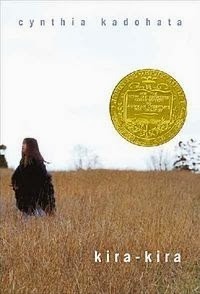
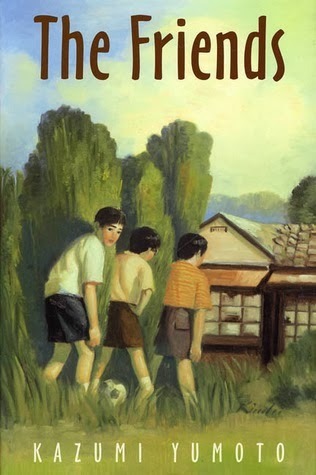
Such great company! I'd love to hear from any teachers who use this activity in their classrooms!
The January edition of Booklist Online features "Classroom Connections: Exploring Japan" by Joyce Herbeck. This Booklist feature article lists Japan-related books--picture books and novels plus nonfiction. It's a great list--have you read all of these Japan-related books for young people?
In addition, in a sidebar supplement and in Book Links magazine, there is a related Common Core Connections feature "Books about Japan and Japanese Americans."

What a pleasure to discover that this Common Core section includes a letter-writing classroom activity that uses three of the novels, including my verse novel Orchards, Cynthia Kadohata's Kira-Kira, and Kazumi Yumoto's The Friends, translated by Cathy Hirano.



Such great company! I'd love to hear from any teachers who use this activity in their classrooms!
Published on February 11, 2014 17:29
February 1, 2014
YALSA 2014 Best Fiction List!
Nice news this week--my verse novel The Language Inside was named by the Young Adult Library Services Association (YALSA) a 2014 YALSA Best Fiction for Young Adults title!

The full list includes 98 titles. As stated on the YALSA site, "This year’s list of 98 books was drawn from 175 official nominations. The books, recommended for ages 12-18, meet the criteria of both good quality literature and appealing reading for teens." I'm so honored that The Language inside was included.

Last week I had a chance to meet readers, many of them young poets, at the Newton Free Library in Massachusetts, and it was so nice to see The Language Inside Guide for Teachers and Readers in full use. I'm looking forward to meeting with more TLI readers and writers, both in person and via Skype, in the coming year.
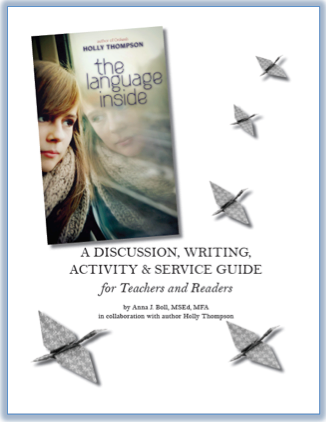
Thank you to all my book folk heroes--my editors, my agent, Delacorte/Random House, librarians and, teachers, readers and writers!

The full list includes 98 titles. As stated on the YALSA site, "This year’s list of 98 books was drawn from 175 official nominations. The books, recommended for ages 12-18, meet the criteria of both good quality literature and appealing reading for teens." I'm so honored that The Language inside was included.

Last week I had a chance to meet readers, many of them young poets, at the Newton Free Library in Massachusetts, and it was so nice to see The Language Inside Guide for Teachers and Readers in full use. I'm looking forward to meeting with more TLI readers and writers, both in person and via Skype, in the coming year.

Thank you to all my book folk heroes--my editors, my agent, Delacorte/Random House, librarians and, teachers, readers and writers!
Published on February 01, 2014 08:03
January 25, 2014
Immigration, Displacement and an Interview
I'm happy to have been featured in diVERSEity Month at VerseNovels.com in a post titled Immigration, Displacement and an interview with Holly Thompson.
 www.versenovels.comThe interview questions focus on identity, language, migration and displacement issues in my verse novel The Language Inside and in my personal life.
www.versenovels.comThe interview questions focus on identity, language, migration and displacement issues in my verse novel The Language Inside and in my personal life.
 The Language Inside
Also featured are verse novels by other authors dealing with these same themes--some of which I've read and enjoyed--Inside Out and Back Again by Thanhha Lai, Under the Mesquite by Guadalupe Garcia McCall, and All the Broken Pieces by Ann Burg. Others--Tropical Secrets by Margarita Engle, Karma by Cathy Ostlere, The Weight of the Sky by Lisa Ann Sandell, and Displacement by Thalia Chaltas I'll be ordering right away.
The Language Inside
Also featured are verse novels by other authors dealing with these same themes--some of which I've read and enjoyed--Inside Out and Back Again by Thanhha Lai, Under the Mesquite by Guadalupe Garcia McCall, and All the Broken Pieces by Ann Burg. Others--Tropical Secrets by Margarita Engle, Karma by Cathy Ostlere, The Weight of the Sky by Lisa Ann Sandell, and Displacement by Thalia Chaltas I'll be ordering right away.
See also the post on Racially Diverse Characters which also offers up a great list of books and includes my verse novel Orchards in the Asia-related titles.
Happy reading!
 www.versenovels.comThe interview questions focus on identity, language, migration and displacement issues in my verse novel The Language Inside and in my personal life.
www.versenovels.comThe interview questions focus on identity, language, migration and displacement issues in my verse novel The Language Inside and in my personal life. The Language Inside
Also featured are verse novels by other authors dealing with these same themes--some of which I've read and enjoyed--Inside Out and Back Again by Thanhha Lai, Under the Mesquite by Guadalupe Garcia McCall, and All the Broken Pieces by Ann Burg. Others--Tropical Secrets by Margarita Engle, Karma by Cathy Ostlere, The Weight of the Sky by Lisa Ann Sandell, and Displacement by Thalia Chaltas I'll be ordering right away.
The Language Inside
Also featured are verse novels by other authors dealing with these same themes--some of which I've read and enjoyed--Inside Out and Back Again by Thanhha Lai, Under the Mesquite by Guadalupe Garcia McCall, and All the Broken Pieces by Ann Burg. Others--Tropical Secrets by Margarita Engle, Karma by Cathy Ostlere, The Weight of the Sky by Lisa Ann Sandell, and Displacement by Thalia Chaltas I'll be ordering right away.See also the post on Racially Diverse Characters which also offers up a great list of books and includes my verse novel Orchards in the Asia-related titles.
Happy reading!
Published on January 25, 2014 14:15
January 8, 2014
On Writing Details--New Video
My EFL creative writing (fiction) students often start out writing stories with cliched and generalized characters, settings and action. I gave myself the challenge of creating a video for my students about details. Instead of using text or making an instructional video with text, I opted to use photos.
Here it is: On Writing Details.
I'm still finding my way with iMovie, so there are some rough spots. Advice is welcome! Feel free to share with your writing classes.
Here it is: On Writing Details.
I'm still finding my way with iMovie, so there are some rough spots. Advice is welcome! Feel free to share with your writing classes.
Published on January 08, 2014 15:25
December 18, 2013
COETAIL--Encounter Plotting: Course 4 Final Project
Another post toward obtaining my Certificate in Educational Technology and Information Literacy (COETAIL)
In a previous post I wrote about experimenting with Twine and Interactive Fiction.
For my COETAIL Course 4 Final Project, I decided to use TWINE and interactive fiction with my university creative writing students. My aim was to encourage them to consider multiple plot possibilities in an exercise prior to writing story starts (the first 300-500 words of a short story) in the "encounter" category (one of four categories of stories I use in this course). My students sometimes get stuck with plots, able to write a beginning, but unable to imagine obstacles and varied outcomes to carry a story through to an interesting and unpredictably fresh ending. I wondered if Twine would help students see that there are an infinite number of possible outcomes for any given story beginning.
Although we met in the language lab for this class period, rather than take up considerable class time with students learning how to create with Twine, I opted to have students use Post-Its on large sheets of paper. After class I would upload the resulting branching story to Twine.

Here is the plan I created for my lesson Twine--Branching Story: Encounter Plotting.
The plan worked well except for one oversight which meant that what resulted was actually four separate group stories rather than four branches of one story. I should have had the class collaboratively map the story until there were four branches, then set each of the four groups to work on a different branch. Regardless of that misstep on my part, the exercise seemed effective and students were immediately immersed in crafting the choices for the story.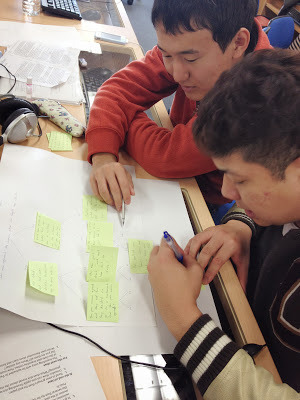 Since we had a limited amount of time for this lesson, some of the branches created by our class groups and pairs were incomplete or redundant, so I combined some branches and added some missing endings. The resulting story "Disco Encounter" below is a compilation of the many branches that students and I wrote--making it a completely collaborative project. It's a bit rough, and there are sections that definitely needed more proofreading, but the process was far more important than the product in this exercise.Click Disco Encounter to read the class story created with Twinery.org. (Press RESTART, or refresh to reload, and start the story again to try different branching options.)
Since we had a limited amount of time for this lesson, some of the branches created by our class groups and pairs were incomplete or redundant, so I combined some branches and added some missing endings. The resulting story "Disco Encounter" below is a compilation of the many branches that students and I wrote--making it a completely collaborative project. It's a bit rough, and there are sections that definitely needed more proofreading, but the process was far more important than the product in this exercise.Click Disco Encounter to read the class story created with Twinery.org. (Press RESTART, or refresh to reload, and start the story again to try different branching options.)

There are many ways in which this lesson might be improved or altered. In future I would allow more time for creating the story branches in class, and I would make certain that the initial branches were equal to the number of groups or pairs collaborating. An alternative would be to allow significantly more time for students to learn to create online with Twine and each group or pair to create their own original branching story.
But as an exercise to limber up their story plotting muscles, the Post-It method worked well, and my inclination would be to have students create the branches with Post-Its and paper again.
The Encounter story starts created subsequent to completing this exercise were overall more ambitious and engaging, and a number of them are now under development--becoming complete short stories that I look forward to reading.
In a previous post I wrote about experimenting with Twine and Interactive Fiction.
For my COETAIL Course 4 Final Project, I decided to use TWINE and interactive fiction with my university creative writing students. My aim was to encourage them to consider multiple plot possibilities in an exercise prior to writing story starts (the first 300-500 words of a short story) in the "encounter" category (one of four categories of stories I use in this course). My students sometimes get stuck with plots, able to write a beginning, but unable to imagine obstacles and varied outcomes to carry a story through to an interesting and unpredictably fresh ending. I wondered if Twine would help students see that there are an infinite number of possible outcomes for any given story beginning.
Although we met in the language lab for this class period, rather than take up considerable class time with students learning how to create with Twine, I opted to have students use Post-Its on large sheets of paper. After class I would upload the resulting branching story to Twine.

Here is the plan I created for my lesson Twine--Branching Story: Encounter Plotting.
The plan worked well except for one oversight which meant that what resulted was actually four separate group stories rather than four branches of one story. I should have had the class collaboratively map the story until there were four branches, then set each of the four groups to work on a different branch. Regardless of that misstep on my part, the exercise seemed effective and students were immediately immersed in crafting the choices for the story.
 Since we had a limited amount of time for this lesson, some of the branches created by our class groups and pairs were incomplete or redundant, so I combined some branches and added some missing endings. The resulting story "Disco Encounter" below is a compilation of the many branches that students and I wrote--making it a completely collaborative project. It's a bit rough, and there are sections that definitely needed more proofreading, but the process was far more important than the product in this exercise.Click Disco Encounter to read the class story created with Twinery.org. (Press RESTART, or refresh to reload, and start the story again to try different branching options.)
Since we had a limited amount of time for this lesson, some of the branches created by our class groups and pairs were incomplete or redundant, so I combined some branches and added some missing endings. The resulting story "Disco Encounter" below is a compilation of the many branches that students and I wrote--making it a completely collaborative project. It's a bit rough, and there are sections that definitely needed more proofreading, but the process was far more important than the product in this exercise.Click Disco Encounter to read the class story created with Twinery.org. (Press RESTART, or refresh to reload, and start the story again to try different branching options.)
There are many ways in which this lesson might be improved or altered. In future I would allow more time for creating the story branches in class, and I would make certain that the initial branches were equal to the number of groups or pairs collaborating. An alternative would be to allow significantly more time for students to learn to create online with Twine and each group or pair to create their own original branching story.
But as an exercise to limber up their story plotting muscles, the Post-It method worked well, and my inclination would be to have students create the branches with Post-Its and paper again.
The Encounter story starts created subsequent to completing this exercise were overall more ambitious and engaging, and a number of them are now under development--becoming complete short stories that I look forward to reading.
Published on December 18, 2013 19:01
COETAIL--EFL Flipped Classroom Thoughts
Another post toward obtaining my Certificate in Educational Technology and Information Literacy (COETAIL)
These days we often hear and read about the merits of the flipped classroom or reverse instruction--the notion of putting lectures or course content on video for students to view at home or at school at their own pace, thus freeing up class time for doing "home"work and mastery exercises. See the infographic The Flipped Classroom Defined and Flipping the Classroom from Vanderbilt University's Center for Teaching. Flipped classroom and reverse instruction methods invert the traditional lecture-based teaching model.
In Japanese universities, the lecture is alive and well, so my non-lecture courses have always been, like those of many other native-speaking language teachers, radically different from the norm. I'm pleased to see Japanese universities [slowly] evolving and more academics adopting alternative teaching methodology and techniques.
How does reverse instruction apply to my EFL content-based university classes focused on creative writing, literature, American culture and global issues, which, like many humanities courses, have actually always been "flipped" highly interactive classes that were never lecture classes to begin with? In many of my courses, students gain first exposure to content through readings completed (theoretically!) prior to class, and class time is for interaction with classmates via discussion or debate, group tasks, prewriting or editing, and interaction with me. The question becomes, then, how might I inject more reverse instruction into my courses? How might I enhance what I do by placing more class materials online?
My university classes meet only once a week, which for language learning is not ideal. Consequently, an important benefit to instructors putting more course content online is that students can view course material again and again, giving them additional listening reinforcement opportunities during the week outside of class. My EFL classes are made up of students with widely ranging abilities in English. Though all have scored over a 600 in the TOEIC test (or the equivalent in TOEFL), some have had little opportunity to actively interact in English; the more content available to them online for previewing or reviewing, the better prepared they will be to actively participate in class.
My students don't usually bring devices other than smart phones into my university classes, and since I teach at a public university, not all students even own computers. However, they all have access to computers in computer labs at the university, so in the last couple years, I have been using WikiSpaces for organizing materials in some of my classes. Initially I did this to cut down on copying, but I quickly realized the Wiki also enables me to share links to readings, videos and audio recordings that can be viewed outside class or in the language lab (occasionally I can reserve it for a class), and also offers options for classmates to interact outside class through comment posts in discussion boards.
To allow for more reverse instruction in which students take more control of their learning, I aim to create WikiSpaces Sites or Google Sites and Docs for each class, move more material online and create content libraries for each class. In my writing classes, I'd like to create screencast tutorials to, for example, illustrate ways to avoid some basic common grammar errors that Japanese EFL writers often fall into, or to demonstrate the use of the Tab key and other formatting tips students may not have learned as they start writing their stories or essays. Video tutorials would save me having to repeat the basic stuff again and again.
I would also like to develop reference libraries and reading links for each course to provide more depth and ample extended opportunities for motivated eager students.
I hope to create some interactive PowerPoints for the Global Issues and American Culture courses to inspire more active directed discussion in class, and the techniques in this video might be applied to some of the material for my classes (though, sigh, I don't have interactive smartboards).
In each of my classes, I can think of ways to move more material online which will leave more class time for the interactive work and individual attention from me, their teacher. More online material directly related to my courses will certainly enable students to take more control of their learning.
Is this flipping? Is this reverse instruction? Perhaps. But I think of it more as an almost sculptural sort of enhancement or refinement of my courses.
Will my university students in my already interactive and quite flipped classrooms take advantage of more material online? Judging from reactions to the Wiki sites I've created thus far, many will. Some won't--those that spend little time on homework anyway or those without a computer at home. And some will still expect to be allowed to be passive students sitting at the back of the classroom nodding off while a teacher lectures. But generally those students either adapt quickly or disappear altogether from my classes. Most of my students in Japan are thirsty for more content and crave more active engagement in class. And no one, after the first day, is allowed to sit in the back of my classroom anyway!
These days we often hear and read about the merits of the flipped classroom or reverse instruction--the notion of putting lectures or course content on video for students to view at home or at school at their own pace, thus freeing up class time for doing "home"work and mastery exercises. See the infographic The Flipped Classroom Defined and Flipping the Classroom from Vanderbilt University's Center for Teaching. Flipped classroom and reverse instruction methods invert the traditional lecture-based teaching model.
In Japanese universities, the lecture is alive and well, so my non-lecture courses have always been, like those of many other native-speaking language teachers, radically different from the norm. I'm pleased to see Japanese universities [slowly] evolving and more academics adopting alternative teaching methodology and techniques.
How does reverse instruction apply to my EFL content-based university classes focused on creative writing, literature, American culture and global issues, which, like many humanities courses, have actually always been "flipped" highly interactive classes that were never lecture classes to begin with? In many of my courses, students gain first exposure to content through readings completed (theoretically!) prior to class, and class time is for interaction with classmates via discussion or debate, group tasks, prewriting or editing, and interaction with me. The question becomes, then, how might I inject more reverse instruction into my courses? How might I enhance what I do by placing more class materials online?
My university classes meet only once a week, which for language learning is not ideal. Consequently, an important benefit to instructors putting more course content online is that students can view course material again and again, giving them additional listening reinforcement opportunities during the week outside of class. My EFL classes are made up of students with widely ranging abilities in English. Though all have scored over a 600 in the TOEIC test (or the equivalent in TOEFL), some have had little opportunity to actively interact in English; the more content available to them online for previewing or reviewing, the better prepared they will be to actively participate in class.
My students don't usually bring devices other than smart phones into my university classes, and since I teach at a public university, not all students even own computers. However, they all have access to computers in computer labs at the university, so in the last couple years, I have been using WikiSpaces for organizing materials in some of my classes. Initially I did this to cut down on copying, but I quickly realized the Wiki also enables me to share links to readings, videos and audio recordings that can be viewed outside class or in the language lab (occasionally I can reserve it for a class), and also offers options for classmates to interact outside class through comment posts in discussion boards.
To allow for more reverse instruction in which students take more control of their learning, I aim to create WikiSpaces Sites or Google Sites and Docs for each class, move more material online and create content libraries for each class. In my writing classes, I'd like to create screencast tutorials to, for example, illustrate ways to avoid some basic common grammar errors that Japanese EFL writers often fall into, or to demonstrate the use of the Tab key and other formatting tips students may not have learned as they start writing their stories or essays. Video tutorials would save me having to repeat the basic stuff again and again.
I would also like to develop reference libraries and reading links for each course to provide more depth and ample extended opportunities for motivated eager students.
I hope to create some interactive PowerPoints for the Global Issues and American Culture courses to inspire more active directed discussion in class, and the techniques in this video might be applied to some of the material for my classes (though, sigh, I don't have interactive smartboards).
In each of my classes, I can think of ways to move more material online which will leave more class time for the interactive work and individual attention from me, their teacher. More online material directly related to my courses will certainly enable students to take more control of their learning.
Is this flipping? Is this reverse instruction? Perhaps. But I think of it more as an almost sculptural sort of enhancement or refinement of my courses.
Will my university students in my already interactive and quite flipped classrooms take advantage of more material online? Judging from reactions to the Wiki sites I've created thus far, many will. Some won't--those that spend little time on homework anyway or those without a computer at home. And some will still expect to be allowed to be passive students sitting at the back of the classroom nodding off while a teacher lectures. But generally those students either adapt quickly or disappear altogether from my classes. Most of my students in Japan are thirsty for more content and crave more active engagement in class. And no one, after the first day, is allowed to sit in the back of my classroom anyway!
Published on December 18, 2013 18:52
December 17, 2013
COETAIL: Enhancing Literature Circles
I have been happily teaching with literature circles for many years, in part thanks to the efforts of a former university colleague. In a Japanese university EFL setting, literature circles provide a helpful structure to enable even shy and hesitant students to participate with confidence in group discussions. I have adapted the basic principles of literature circles to develop my own collection of literature circle guides for use with authentic literature texts in my university courses--Poetry Circles, Short Story Circles and Literature Circles for Novels.
I teach in a traditional environment in which students have limited access to technology during class. Although many students now have smart phones, students rarely bring a laptop or iPad to class. Wifi is available in classrooms but often impossibly slow and generally inaccessible by computer--though easier to access with smart phones. Occasionally I can teach in a language lab with computer access for all students, but most of my classes are taught in standard classrooms with many desks, a blackboard, and a single computer and projector with a LAN connection.
Given this environment, my literature circles have rarely integrated technology.
But I was intrigued to read Literature Circles Part 1 and Literature Circles Part 2 on the Langwitches blog about an innovative way in which one humanities teacher is integrating technology into grade 6 literature circles discussions. This teacher had the students videotaping their own literature circles discussion, uploading the video, blogging about the process, then digitally analyzing and annotating (or annotexting) the video, and writing a self-reflection blog post.
I'd love to try a similar approach with my university students. If only I had a 1:1 classroom environment in which all students had equal access to technology tools, was my first thought. But actually, now with so many smart phones in university classrooms in Japan, it might be possible to ask students to video record their discussions and analyze and edit those recordings to add another layer of learning.
This semester my Literature Circles for Novels course was disrupted by my sudden relocation to the U.S. for a family health emergency. I am now monitoring student progress from afar. Recently I had my students take photos of the character maps and plot diagrams created during class and share those with me digitally which enabled me to view evidence of their class work without needing a hard copy sent to me. In the future, when teaching face-to-face again, I'd like to take this a step further and have the students upload photos and other evidence of their literary discussions to a blog.
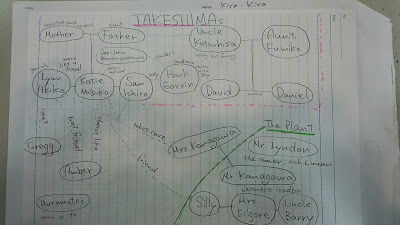 character map of Kira-Kira by Cynthia Kadohata
character map of Kira-Kira by Cynthia Kadohata
 character map for Feathers by Jacqueline Woodson
character map for Feathers by Jacqueline Woodson
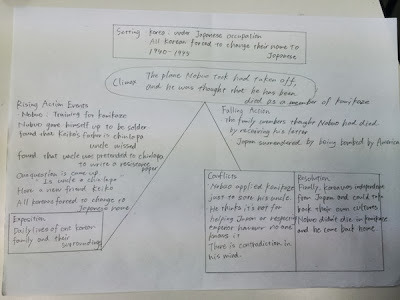 Plot diagram for When My Name Was Keoko by Linda Sue ParkStudents will soon be sharing their novel reflections with me digitally, and after the New Year break, during the flash fiction unit, they will be sharing an original flash fiction story with me digitally.
Plot diagram for When My Name Was Keoko by Linda Sue ParkStudents will soon be sharing their novel reflections with me digitally, and after the New Year break, during the flash fiction unit, they will be sharing an original flash fiction story with me digitally.
Otherwise, thanks to a substitute instructor, the literature circles for novels have been carried out with little technology. Literature circles are quite magical. Groups of non-native English speakers taking full control of discussions of books they selected themselves and actively analyzing, questioning, interpreting and critiquing is wonderful to witness. The Japanese professor covering my classes witnessed this literature circle magic and commented, "It was inspiring to learn from your methodology. I have to learn from you how you have successfully inspired the students to participate in the class so actively."
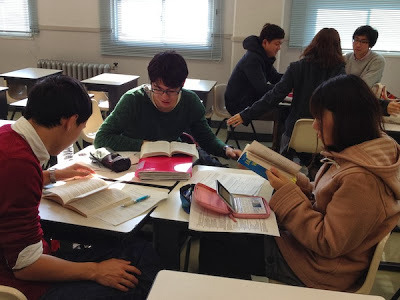 group literature circle discussionsIf it's not broke, why fix it, I've wondered with literature circles. But now I think that enhancing literature circles is my aim--by adding a blogging component to enable sharing photographic evidence of work and analysis of a video recording to help student measure and improve their literary discussion skills.
group literature circle discussionsIf it's not broke, why fix it, I've wondered with literature circles. But now I think that enhancing literature circles is my aim--by adding a blogging component to enable sharing photographic evidence of work and analysis of a video recording to help student measure and improve their literary discussion skills.
I teach in a traditional environment in which students have limited access to technology during class. Although many students now have smart phones, students rarely bring a laptop or iPad to class. Wifi is available in classrooms but often impossibly slow and generally inaccessible by computer--though easier to access with smart phones. Occasionally I can teach in a language lab with computer access for all students, but most of my classes are taught in standard classrooms with many desks, a blackboard, and a single computer and projector with a LAN connection.
Given this environment, my literature circles have rarely integrated technology.
But I was intrigued to read Literature Circles Part 1 and Literature Circles Part 2 on the Langwitches blog about an innovative way in which one humanities teacher is integrating technology into grade 6 literature circles discussions. This teacher had the students videotaping their own literature circles discussion, uploading the video, blogging about the process, then digitally analyzing and annotating (or annotexting) the video, and writing a self-reflection blog post.
I'd love to try a similar approach with my university students. If only I had a 1:1 classroom environment in which all students had equal access to technology tools, was my first thought. But actually, now with so many smart phones in university classrooms in Japan, it might be possible to ask students to video record their discussions and analyze and edit those recordings to add another layer of learning.
This semester my Literature Circles for Novels course was disrupted by my sudden relocation to the U.S. for a family health emergency. I am now monitoring student progress from afar. Recently I had my students take photos of the character maps and plot diagrams created during class and share those with me digitally which enabled me to view evidence of their class work without needing a hard copy sent to me. In the future, when teaching face-to-face again, I'd like to take this a step further and have the students upload photos and other evidence of their literary discussions to a blog.
 character map of Kira-Kira by Cynthia Kadohata
character map of Kira-Kira by Cynthia Kadohata
 character map for Feathers by Jacqueline Woodson
character map for Feathers by Jacqueline Woodson
 Plot diagram for When My Name Was Keoko by Linda Sue ParkStudents will soon be sharing their novel reflections with me digitally, and after the New Year break, during the flash fiction unit, they will be sharing an original flash fiction story with me digitally.
Plot diagram for When My Name Was Keoko by Linda Sue ParkStudents will soon be sharing their novel reflections with me digitally, and after the New Year break, during the flash fiction unit, they will be sharing an original flash fiction story with me digitally. Otherwise, thanks to a substitute instructor, the literature circles for novels have been carried out with little technology. Literature circles are quite magical. Groups of non-native English speakers taking full control of discussions of books they selected themselves and actively analyzing, questioning, interpreting and critiquing is wonderful to witness. The Japanese professor covering my classes witnessed this literature circle magic and commented, "It was inspiring to learn from your methodology. I have to learn from you how you have successfully inspired the students to participate in the class so actively."
 group literature circle discussionsIf it's not broke, why fix it, I've wondered with literature circles. But now I think that enhancing literature circles is my aim--by adding a blogging component to enable sharing photographic evidence of work and analysis of a video recording to help student measure and improve their literary discussion skills.
group literature circle discussionsIf it's not broke, why fix it, I've wondered with literature circles. But now I think that enhancing literature circles is my aim--by adding a blogging component to enable sharing photographic evidence of work and analysis of a video recording to help student measure and improve their literary discussion skills.
Published on December 17, 2013 11:17



